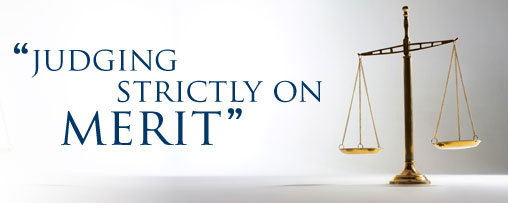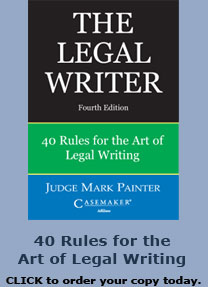The Legal Writer #27: How To Fix Bad Writing
By Judge Mark P. Painter
|
Let us begin with a recent example from OBar. I won’t give the citation because the authorship is not important. Plus I have enough enemies. This is just one paragraph; you can imagine the rest. In considering a plaintiff’s request for leave to amend, “a trial court’s ‘primary consideration is whether there is actual prejudice to the defendants because of the delay.'” Helman v. EPL Prolong, Inc. (2000), 139 Ohio App.3d 231, 251, 743 N.E.2d 484, citing Schweizer v. Riverside Methodist Hosp. (1996), 108 Ohio App.3d 539, 546, 671 N.E.2d 312. Although we have held in a case involving the assertion of a new claim against an existing defendant that the plaintiff must make “‘at least a prima facie showing [of] support for the new matters sought to be pleaded,'” that consideration is meant to aid in determining whether the amendment is ‘”simply a delaying tactic, [or] one which would cause prejudice to the defendant.'” Wilmington Steel Products, 60 Ohio St.3d at 122, 573 N.E.2d 622, quoting Solowitch v. Bennett (1982), 8 Ohio App.3d 115, 117, 8 OBR 169, 456 N.E.2d 562. Indeed one federal court has refused to allow a proposed new party, yet unserved, to appear at all, even as an amicus, in opposition to a motion to add it as a party-defendant in an existing action. Paradigm Ins. Co. v. Walters Diving & Marine, Inc. (E.D.La.1999), No. 98-1617, 1999 WL 232669. See, also, In re Everfresh Beverages, Inc. (1999), 238 B.R. 558, 569, fn. 8 (observing in ruling on a motion to add additional defendants pursuant to Fed.R.Civ.P. 15(a) that “[t]he Proposed Additional Defendants’ rights, including objecting to the Plaintiffs’ complaint on the ground of timeliness” were not before the court). The paragraph is unreadable. It’s littered with quotes, and quotes within quotes. There are letters and numbers jumbled up in the middle. And it even cites a footnote. It has some redeeming values — the author at least didn’t write “aid in the determination of” instead “aid in determining.” And mercifully, there are no passive sentences. But its word-per-sentence count is 42. The Flesch-Kincaid readability score is 24 (out of 100). First, we take out the worst offense and remove the citations to footnotes, and we have this: In considering a plaintiff’s request for leave to amend, “a trial court’s ‘primary consideration is whether there is actual prejudice to the defendants because of the delay.'”1 Although we have held in a case involving the assertion of a new claim against an existing defendant that the plaintiff must make “‘at least a prima facie showing [of] support for the new matters sought to be pleaded,'” that consideration is meant to aid in determining whether the amendment is “‘simply a delaying tactic, [or] one which would cause prejudice to the defendant.'”2 Indeed one federal court has refused to allow a proposed new party, yet unserved, to appear at all, even as an amicus, in opposition to a motion to add it as a party-defendant in an existing action.3 1 Helman v. EPL Prolong, Inc. (2000), 139 Ohio App.3d 231, 251, 743 N.E.2d 484, citing Schweizer v. Riverside Methodist Hosp. (1996), 108 Ohio App.3d 539, 546, 671 N.E.2d 312. 2 Wilmington Steel Products, 60 Ohio St.3d at 122, 573 N.E.2d 622, quoting Solowitch v. Bennett (1982), 8 Ohio App.3d 115, 117, 8 OBR 169, 456 N.E.2d 562. 3 Paradigm Ins. Co. v. Walters Diving & Marine, Inc. (E.D.La.1999), No. 98-1617, 1999 WL 232669. See, also, In re Everfresh Beverages, Inc. (1999), 238 B.R. 558, 569, fn. 8 (observing in ruling on a motion to add additional defendants pursuant to Fed.R.Civ.P. 15(a) that “[t]he Proposed Additional Defendants’ rights, including objecting to the Plaintiffs’ complaint on the ground of timeliness” were not before the court). Still difficult, but a start. Next, let’s try to cut down the sentence length by purging some of the quotes. In considering a plaintiff’s request for leave to amend, the primary consideration is prejudice to the defendant.1 In a case involving the assertion of a new claim against an existing defendant, we have held that the plaintiff must make a prima facie showing of “support for the new matters sought to be pleaded.” But that consideration is to help the trial court determine whether the amendment is a delaying tactic, or one to prejudice the defendant.2 One federal court has even refused to allow a proposed new party, yet unserved, to appear at all, even as an amicus, to oppose a motion to add it as a party-defendant in an existing action.3 (footnotes omitted). This revision gets words-per-sentence down to 24 from 42, and readability up to 39 from 24. But it’s still not very good. One problem is that I can’t really tell what this paragraph is about. So I went back and read the case again. The paragraph is redundant, so it can be cut altogether. That makes 0 words-per-sentence. |
____________________________________
Mark Painter is a judge on Ohio First District Court of Appeals and an Adjunct Professor at the University of Cincinnati College of Law. He is the author of five books, including The Legal Writer 2nd Ed.: 40 Rules for the Art of Legal Writing. The book is available at the Ohio Bookstore in Cincinnati, Joseph-Beth Booksellers in Cincinnati and Cleveland, the Book Loft in Columbus, and from Lawyers Weekly Books at http://books.lawyersweekly.com. Judge Painter has given more than three dozen seminars on legal writing. Contact him through his website at www.judgepainter.org.








